 Your new post is loading...
 Your new post is loading...
"UCL researchers have developed a revolutionary new type of ‘smart’ window which could cut window-cleaning costs in tall buildings while reducing heating bills and boosting worker productivity. The windows use nature inspired nanostructures which mimic the eyes of moths to cut glare, save energy and clean themselves."
"Light scattering means that many synthetic oil-repellent surfaces are opaque, limiting their use. A transparent, oil-repellent surface would have applications in biology and underwater optics, including in diving goggles and cameras. Now, Feng Chen’s research group at Xi’an Jiaotong University has developed such a material. Fish repel oil by trapping water within their scales to create a self-cleaning, oil-repellent coat and prompted part of the idea behind the work. Chen’s other brainwave was triggered by Diphylleia grayi – also known as the skeleton flower."
"The spread of antimicrobial resistance with the emergence of 'super-bugs' that resist even 'last-resort' antibiotics has prompted the World Health Organisation (WHO) to formally tackle the problem of an unwanted post-antibiotic era. [...] A notable solution is provided by an unlikely source - the cicada.The wings of this small fly display bactericidal nanoscale pillar structures. Each of these pillars is a pike of several tens of nanometers in diameter and is separated from other pikes at regular nanometer intervals. Densely packed on the wing surfaces, these pillars arrange into nanopatterns which pierce the membranes of bacterial cells on contact, tearing bacteria apart. Inspired by this example, a research team from NPL and the School of Oral and Dental Sciences at the University of Bristol engineered biocompatible surfaces exhibiting nanowire arrays."
"Engineers have figured out how to make rounded crystals with no facets, a design that mimics the hard-to-duplicate texture of starfish shells. The discovery could one day lead to 3D-printed medications that absorb better into the body."
"Technology inspired by the exoskeleton of a hardy desert bug is being aimed at big industrial problems, and investors are betting several million dollars that it could make a difference."
"As nocturnal creatures, moths need to maximize how well they can see in the dark whilst remaining less visible to avoid predators. This ability to collect as much of the available light as possible and at the same time reflect as little as possible, has inspired Researchers at the Swiss Federal Laboratories for Materials Science and Technology (Empa) to design a new type of photoelectrochemical cell using relatively low cost materials."
By mimicking the design of a firefly's light-emitting organ, researchers built an LED that shines 55 percent brighter.
"It's a familiar trope in science fiction: In enemy territory, activate your cloaking device. And real-world viruses use similar tactics to make themselves invisible to the immune system. Now scientists at Harvard's Wyss Institute for Biologically Inspired Engineering have mimicked these viral tactics to build the first DNA nanodevices that survive the body's immune defenses."
"Imitating nature is not a new idea. When the GE team put Morpho wings under a powerful microscope, they saw a layer of tiny scales just tens of micrometers across. In turn, each of the scales had arrays of ridges a few hundred nanometers wide. This complex structure absorbs and bends light and givesMorfo butterflies their trademark shimmering blue and green coat."
"The Mirasol display technology (developed by Qualcomm) is based on biomimetics - that is, technology that imitates nature. The natural phenomenon that makes a butterfly’s wings or a peacock’s feathers shimmer and give off their rich, striking colors is the same exact quality that drives how Mirasol displays generate color. How do butterflies and peacocks do it? Through microscopic structures on their wings and feathers they are each able to create truly vivid colors simply by causing light to interfere with itself. This "interference" is the reason the term "interferometric" comes into play."
"The future of advanced medicine may very well depend on our collective understanding of nano-scale biological systems. Certain embedded nanotechnology and medicine delivery mechanisms could rely heavily on our knowledge of cell membranes. Unfortunately, it is challenging to conduct thorough research on the membranes of live cells due to the fact that not all variables of living systems can be controlled. For this reason, biomimetic membrane research is an important field of study for scientists to explore. Biomimetic (as in, mimicking biology) membranes are a synthetic recreation of biologically occurring membranes, with very similar properties."
A new nanostructured material may lead to surfaces that stay dry forever, never need cleaning and are able to repel bacteria and even prevent mold and fungi growth. "The newly discovered material uses raspberry particles -- so-called because of their appearance -- which can trap tiny water droplets and prevent them from rolling off surfaces, even when that surface is turned upside down," said Dr Andrew Telford from the University's School of Chemistry and lead author of the research recently published in the journal, Chemistry of Materials. The raspberry particles mimic the surface structure of some rose petals.
"For a long time, scientists have been fascinated by the dramatic changes in color used by marine creatures like squids and octopuses, but they never quite understood the mechanism responsible for this. Only recently they found out that a neurotransmitter, acetylcholine, sets in motion a cascade of events that culminate in the addition of phosphate groups to a family of unique proteins called reflectins. This process allows the proteins to condense, driving the animal's color-changing process. The latest findings revealed that there is a nanoscale mechanism behind cephalopods' ability to change color."
|
"The effect is known from the smart phone: Sun is reflected by the display and hardly anything can be seen. In contrast to this, the glasswing butterfly hardly reflects any light in spite of its transparent wings. As a result, it is difficult for predatory birds to track the butterfly during the flight. Researchers of KIT under the direction of Hendrik Hölscher found that irregular nanostructures on the surface of the butterfly wing cause the low reflection. In theoretical experiments, they succeeded in reproducing the effect that opens up fascinating application options, e.g. for displays of mobile phones or laptops."
"Researchers at the University of California at Berkeley announced today that they have developed an ultra-thin material that can change color on demand by bouncing back light on the nanoscale level. Well, the on-demand element is a little more nuanced. The “chameleon skin” material actually changes color when flexed, or when a small amount of force is applied to the surface."
"Nano-imprint technology, a technique in which microscopic indentations are made on an object's surface, is changing the nature of various products, including TV screens, semiconductors and tissue cultures. One application already being used is in making so-called moth-eye film, a transparent film developed by Dai Nippon Printing that reflects almost no light. This film is modeled after a moth's eyes, which are known for reflecting little to no light, allowing the insect to better hide from predators. This is achieved by minute bumps that are around 200 nanometers, 200 billionths of a meter, in diameter. Nano-imprint technology helped researchers create such surfaces on film."
"Sharks have tough skin that is worthy of biomimicry by nanotechnology designers and engineers. New coatings, textiles and other technologies that mimic the special biological properties of shark skin have been developed in recent years and many more such innovations are emerging across multiple industries."
"In the Namib Desert of Africa, the fog-filled morning wind carries the drinking water for a beetle called the Stenocara. iny droplets collect on the beetle's bumpy back. The areas between the bumps are covered in a waxy substance that makes them water-repellant, or hydrophobic (water-fearing). Water accumulates on the water-loving, or hydrophilic, bumps, forming droplets that eventually grow too big to stay put, then roll down the waxy surface. [...] More than a decade ago, news of this creature's efficient water collection system inspired engineers to try and reproduce these surfaces in the lab. Small-scale advances in fluid physics, materials engineering and nanoscience since that time have brought them close to succeeding."
"Researchers in the lab of Rice materials scientist Pulickel Ajayan found a way to mimic the Stenocara beetle, which survives in the desert by stretching its wings to capture and drink water molecules from the early morning fog. They modified carbon nanotube forests grown through a process created at Rice, giving the nanotubes a superhydrophobic (water-repelling) bottom and a hydrophilic (water loving) top. The forest attracts water molecules from the air and, because the sides are naturally hydrophobic, traps them inside."
"We studied a novel photoanode structure inspired by butterfly wing scales with potential application on dye-sensitized solar cell in this paper. Quasi-honeycomb like structure (QHS), shallow concavities structure (SCS), and cross-ribbing structure (CRS) were synthesized onto a fluorine-doped tin-oxide-coated glass substrate using butterfly wings as biotemplates separately."
"Moth eyeballs are made up of tiny cones that reduce glare. UC Irvine researchers copied the pattern on a new, flexible material and coated it with a bit of gold to make a product that could improve solar panels, LED displays and disguising of weapons."
"The TED2014 conference kicks off today in Vancouver, marking the 30th anniversary of the event. The theme of this year's conference is "the next chapter," and each attendee will receive a sample of what could be the next chapter in anti-counterfeit technology. The TED2014 ID badges feature a small iridescent panel with a "30 years TED" logo. The image isn't a hologram, but is created by billions of nano-scale holes. The technology is inspired by the wings of the Morpho butterfly, and this is one of its first major real-world applications. The super-tiny holes reflect and transmit light in a distinctive way, making the logo easy to identify and hard to copy."
"Butterfly wings can do remarkable things with light, and humans are still trying to learn from them. Physicists have now uncovered how subtle differences in the tiny crystals of butterfly wings create stunningly varied patterns of color even among closely related species. The discovery, reported today in the Optical Society's (OSA) open-access journal Optical Materials Express, could lead to new coatings for manufactured materials that could change color by design, if researchers can figure out how to replicate the wings' light-manipulating properties."
Norwegian researchers are using insights from the animal kingdom in their quest to design new self-cleansing and water-repellant surface materials.
By mimicking microscopic structures in the wings of a butterfly, an international research team has developed a device smaller than the width of a human hair that could make optical communication faster and more secure.
|
 Your new post is loading...
Your new post is loading...
 Your new post is loading...
Your new post is loading...








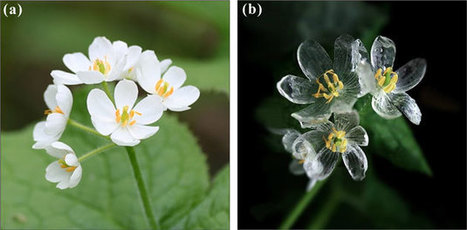

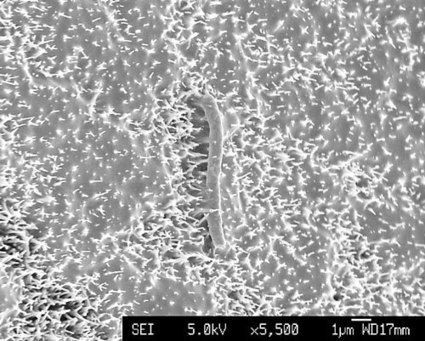

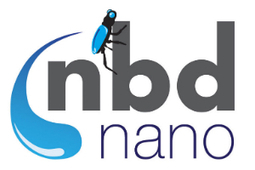
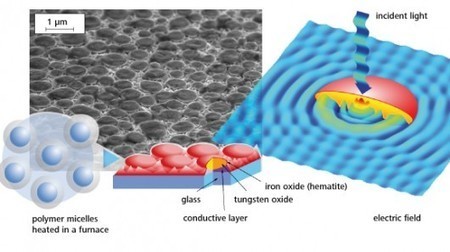












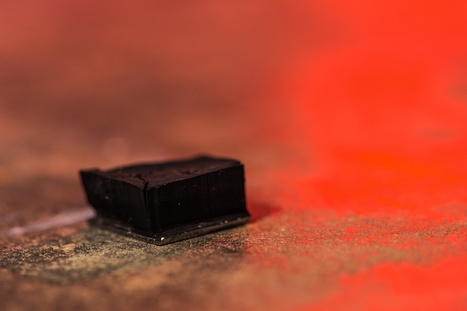


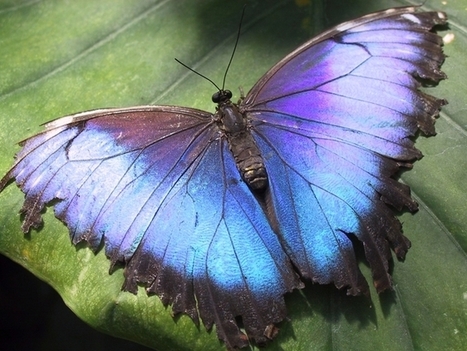








un nouveau verre associant nano structures en cônes et dioxyde de vanadium, pour éviter salissures, éblouissement et échanges thermiques